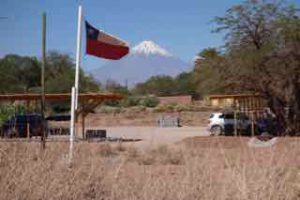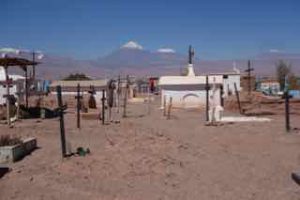The Atacama Desert
Posted on October 7, 2018 - Leave a Comment
Trekking the Atacama
The Highs and Lows of the Chilean Desert
Cliff Lancey
My friend and I were sipping wine beneath an Algarrobo tree when a tall fellow crossed the courtyard and introduced himself. His name was Wilhelm, a German Peruvian from Argentina. He preferred to be called Billy. Billy was working as a freelance guide. The Chilean border is pretty open to Argentine passports, but not for work. This job, Ken and me, he let us know, was just the other side of the law. No problem, he assured us.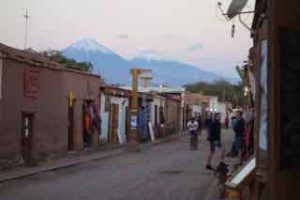
This is San Pedro, a town in the Atacama Desert. We crossed the desert from Calama a few days ago. Much of the scenery has a patina of white – salt – except for the snow-capped mountains. The Andes rise so high it is hard through the haze to tell the white peaks from the clouds.
Calama is a mining town, a remote corner of the extraction industry that is a major part of the economy. The road from Calama runs straight as a string through the desert of the Atacama.
We are in what was once Bolivia. The two countries fought a war – the War of the Pacific – over the nitrate deposits. Bolivia lost. The desert and the seacoast to the west have been part of Chile ever since.
The outskirts of Calama are monochromatic in the blistering afternoon sun, brown apartment blocks the color of the desert beyond. It is North Las Vegas without the charm. The personality of the desert changes with the miles. Outside Calama the table-flat plain changes to lumpy red hills and broken cliffs.
A dust devil spins across the road and flies apart. In the distance a solitary transmission line runs obliquely to the horizon. As we climb, clumps of yellow grass start to dot the roadside. There is no other sign of life. The few dessicated plants, we read, draw moisture from fog. It never rains.
We ascend a plateau. The mountains that seemed so far away are nearer now, looming high against the sky. Most are in the shape of cones – the hulls of old volcanoes.
At the top it seems like the desert unfolds before us. It’s a landscape from science fiction, empty surreal distances stretching to the horizon. In the middle distance the land is broken into canyons and spiky outcrops. Beyond that, nothing, a whiteness gone to haze. The road winds through a corridor of rubble into a shady cut where hoodoos stand at attention; then out again onto the sun-blasted plain.
Finally there’s a village, its narrow lanes hemmed by rock walls. The vehicle lurches to a stop in a cloud of dust. The driver yells Takha Takha, my hotel. I am half asleep from an overnight flight, the altitude, the torpor of the desert.
A carriage door swings open onto a courtyard. Inside are trees and welcoming shade. Ken greets me, a glass of wine in one hand, a cigarette in the other. He pinches the cigarette between his lips to grab a bag. Welcome to San Pedro de Atacama, he says, the garden spot of Chile.
San Pedro is an oasis town. From the cliffs above the desert floor, the village is a green patch on the bleached hide of the Atacama. It is at once fascinating and appalling, a wasteland of salt flats and spiny gulches, a canvas stretching to the horizon in a palette of bleached brown. In the distance, beyond the rooftops, is the salar, the Atacama Salt Flat, stretching to the south. Rising beyond are the mountains, defunct volcanoes, the impossibly high country of Bolivia.
The village is watered by the slender thread of the Rio San Pedro. It begins in the Altiplano to the north and expires just a few miles south in the salt flat. A network of small aqueducts carries the muddy water into fields and courtyards. There is a schedule and a day when they turn a tap for each part of the village. The concrete channels, most no more than a foot wide, are the margin between the tolerable shade of the Algarrobo trees and the parched void that lies beyond.
Aside from a one-lane dirt strip called Caracoles where the tour agencies and eateries cater to the Chilean tourists, the town is a scorched jumble of adobe homes and walled yards pressed up against the dust-choked streets. Sheets of corrugated metal, some held down with rocks, keep out the rain.
But rain isn’t much of a problem. It rains so little in the Atacama that its ecology has been studied as an approximation of Mars. Science suggests that if microbes can live here, where it hasn’t rained in a hundred years, they can live on Mars. To witness the barren sands stretching in every direction, I can see the point.
The darkened entries of the small storefronts all have sign boards plunked in the dirt advertising geysers, volcanoes, lagunas, sandboarding, and super “ofertas” for the Valle de la Luna. The Valley of the Moon. Nobody speaks much English. I have been trying to learn some Spanish. I’m about to find out how much.
The idea of tourism is dissonant in a place like this. Tourism connotes something almost religious in its consensus. Tourists come to see what other tourists have seen, to be awed by the majesty of El Capitan, the brazen distances of the Grand Canyon. It’s all defined and filtered, reduced to a simulacrum of real experience. Seen so often, these places are no longer seen at all.
Then there is this wilderness of desert. For several days we saw no one. Not another hiker. These austere distances are on no one’s bucket list. The motive to travel here is more idiosyncratic, to find something different. In making sense of the place there are mostly blanks to be filled in. There is a tug of a primeval wonder.
We’re not sure why we’re here. It’s almost a joke. Neither of us can quite remember whose idea it was. Part of the answer I think lies in our lost kinship with nature, an urge to make contact with what lies beyond the frontier of comfort and familiarity.
The narrow, dusty lanes give San Pedro a primitive, time-forgotten quality, though virtually every hut has a satellite dish, and every worker seems to have a tool in one hand and a phone in the other.
The images of urban culture permeating the world’s far corners are said to be the root of social unrest. But there are few signs of Maoism in San Pedro. Billy is the closest thing. A socialist, a proud beneficiary of the Argentine welfare state, but happy enough to confess that he detours his money through Germany to avoid the welfare state taxes.
The political winds blow a little differently he says. Elsewhere in the world the indigenous people live in communities of poverty and despair. In San Pedro, the Atacamenos, the ancient people, are the ones in charge. They are certainly a race apart from the Chilean women, the tall, dark-eyed beauties who have perfected the Creole ancestry. The Atacamenos are short, thickset, with round dark faces.
At a security point a young Atacameno in a green uniform looked at Billy’s permit. He was short but powerfully built, with a broad face, his expression indifferent behind wraparound shades. His jet black hair was shaven on the sides, but long on top and tied in a flowing top knot. He did not look like a guy to mess with.
The women on the other hand, even the young, are plump and figureless, with the symmetry of an oil barrel. Although the Chilean women enrich the landscape, every tienda, bodega and bar seems to be run by the Atacamenos. In a land whose oppression by the Spanish has left an indelible stain, it is hard to imagine how they pulled it off.
Down a winding lane, the tour companies and shops in the village center yield to pastures and vacant yards. In a land of few trees, the Atacamenos build with rock. Every courtyard lies behind a rock wall. There is an air of seclusion. Living at the edge of such a boundless, lifeless expanse, there must be a craving for scale, privacy, the reassurance of close and ordered space.
At the end of one road I head down another which runs to the edge of town. The walls and yards end. It happens quickly. Here a house, a courtyard; there but a hundred yards away, the end of civilization, an infinite vista of sand and salt. Nearby, a wind-break of some sort has not worked out. A line of shrubs planted in the uptipped cavities of cinder blocks has gone wilted and brown, a forlorn screen of withered sticks.
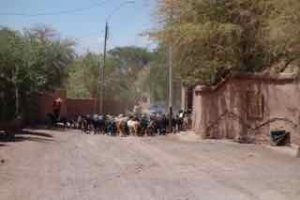 Where the road bends around a shady corner, there is a commotion of some sort. The road is full of goats led by two donkeys and followed by an Atacameno herder tapping the ground with a stick.
Where the road bends around a shady corner, there is a commotion of some sort. The road is full of goats led by two donkeys and followed by an Atacameno herder tapping the ground with a stick.
I step past a woman walking a large dog to get closer. The hooves make a muffled clattering in the dirt. The donkeys are now even with me. I stroke them on their hard, hairy snouts. The dog goes suddenly ballistic, lunging and snarling, his teeth flashing, the woman wrestling with his leash. The animal is completely out of his frame and has not ruled me out as target preference. I slip sideways patting the donkeys, preferring to be nibbled by goats to being devoured by this mastiff.
On the map, Rio San Pedro lies up a nearby road at the outskirts of the village. The afternoon heat is wilting. Like almost all of the streets Calle Domingo is unpaved and the dust is awful. Each bone dry dirt track I wander seems to attract a convoy of traffic. A bus and two SUVs pass. A miasma of dust billows from the bus. The SUVs add their contribution to the mushrooming cloud. Nobody seems much distressed. They bicycle through this tempest as if it were nothing.
In the morning we head south to Toconao and up to the Altiplanico lagoons. Reaching east and north into Peru and Bolivia is the Altiplano, the high plain of the Andes. The Altiplano rises to remarkable elevation. We criss-cross it several times, from a manageable 10,000 feet to an enervating 14,000 feet. It is literally sickening – at least to me.
Between Ken and me, it is I who is the weak link. I sag at 14,000 feet, head-achey, dog sick, usually followed by a zombie-like coma, from which I emerge a day later my winsome self. Ken is a good friend, and has agreed to hang around San Pedro a few days to let me get acclimated – basically so I don’t screw everything up by getting sick.
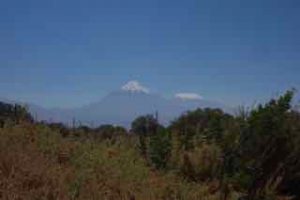 On a rising scrub plain above 11,000 feet we leave the pavement and head east, winding into the mountains. Not too far away is ALMA, the large radio telescope. The stars are bright out here, enhanced by the elevation and lack of water vapor. Licancabur, a postcard perfect volcanic cone on the Bolivian border, dominates the sky. The peak is more than 18,000 feet high. It is huge, visible almost everywhere, worshipped by the Atacamenos, they say. Nearby, steam rises from Volcan Lascar, one of the few active volcanoes.
On a rising scrub plain above 11,000 feet we leave the pavement and head east, winding into the mountains. Not too far away is ALMA, the large radio telescope. The stars are bright out here, enhanced by the elevation and lack of water vapor. Licancabur, a postcard perfect volcanic cone on the Bolivian border, dominates the sky. The peak is more than 18,000 feet high. It is huge, visible almost everywhere, worshipped by the Atacamenos, they say. Nearby, steam rises from Volcan Lascar, one of the few active volcanoes.
We approach a ridge of golden hills. The pale thread of road slips out of sight up ahead but reappears as a thin line tracing the top of the ridge. I am growing sleepy with the altitude which is approaching 13000 feet.
The Miscanti Laguna and it’s sister Mineques are cerulean blue, pendant jewels in a setting of salt, surrounded by snowy peaks. The opaque blue water is hypnotizing, ethereal as a cloud yet with a density like a bowl of paint.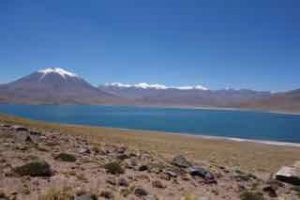
The lagoons are saline and support little life beyond tiny brine shrimp. But the shrimp are the staple food of the flamingoes, who flock to the shallow waters. Los Flamencos are a big tourist draw.
Salt is everywhere. We visit a cavern whose dusty brown walls belie that the whole thing is salt. Press the wet end of a finger into a crevice and it comes back salty. Walls of salt groan and crack in the afternoon sun.
The trek begins. Billy picks us up in a small truck with two other guys, Ruben and Ariel. Billy is the only one who speaks any English. We heave our bags in back and jam into the truck. We head north into the desert, climbing away from San Pedro. A few miles in, the road disintegrates into ruts cut into the hard dirt the color of dishwater. The truck stops. We seem to be in no discernible place. The thought crosses my mind that they could rob us and kill us. Not even the birds would find us out here.
But Billy, we are learning, is a good fellow, and suggests we walk slowly at first to gauge our acclimatization. Even with some imagination there is nothing that suggests a trail. As if in some existential reverie, we simply start walking toward nothing. We climb to a cliff and follow the ledge which becomes more or less the route.
Beautiful may not be the perfect word for this tough, hostile landscape, but it is nevertheless a place of awe and even mystery. From the cliffs we look down upon the Valle de la Muerte – The Valley of the Dead.
The floor of the valley is a warren of sand dunes and rocky spires. It is all sand and rock and stony gravel baking in the sun, a no-man’s land. There isn’t a tuft of grass. Dry and desolate, yes, but not exactly dead. On a far off sand dune we make out people. They are sandboarders. They strap themselves into what are really snowboards, and catch the dry waves.
We come to a place where an enormous dune rises to the lip of the cliff, Billy hops into the sand, and we descend. We climb up and down the dunes, our boots filling with sand. It is a challenge. The sand is moving underfoot and we with it. Ken and Billy look like survivors of the apocalypse staggering over the empty dunes. Finally we slip down into a gravel wash, winded, and stop for a drink. No one said crossing the Valley of the Dead would be easy.
For a morning we crash around dry river bottoms in the truck. I am growing fond of it. My yen for a little adventure is matched by an affection for tossing empty beer cans in the back of a pickup. But there’s not much room back there. The bed is piled high with trek equipment. The gray vehicle looks vaguely like an elephant with a rounded hump of equipment bundled under a bedraggled gray tarp
Our first full day is to climb. We are already at 11000 feet. We walk slowly. Even a couple of brisk steps leaves us breathless. We spend the morning climbing to 13000 feet. Even with just daypacks, it is exhausting.
Camp appears to be wherever Billy decides to stop. There are no campgrounds or fire-rings or shady groves; there’s nothing. We pull off among the outcrops. One place looks as good as another. We smooth the rubble and pitch a tent. Billy and Ruben set up the kitchen tent, that looks to be about a hundred years old, but serviceable. They haul a couple of large coolers and boxes, and unfold a table.
As Ken and I put up the tent, we discover not ten feet away a panel of petroglyphs on a large rock, a suite of animal figures and totems etched into the stone eons ago.
Billy sets up a cook stove. He slices a melon. A bottle of wine appears. Billy slices tomatoes, onions and avocados while something simmers in a pot. Dinner is humita, a Chilean dish of raw vegetables over a cornmeal tamale.
It grows quickly dark once the sun sets. Dinner over, we step outside the kitchen tent. The night sky is flooded with stars, so close they seem within reach.
Next day we are in the canyon of the Rio Grande, a tributary of the San Pedro. The sun is bright. We hike nearly all day through a gravelly wash, crossing and re-crossing the shallow river.
This is the Altiplano, almost as dry as the desert below, but braided with small streams draining the summer melt of the mountains to the east. Most of the river bed is dry and choked with rocks and boulders. There is no trail. Billy wanders ahead, climbing boulders, scouting a path. The boulder hopping is tiring.
Higher in the canyon we hear a sound like the honk of a car horn. We look at Billy. He points to a grove of trees against the far canyon wall. We see mostly ears. Wild burros. They are not native. Years ago, when the mines closed, they simply turned the burros loose.
They have multiplied. We stumbled across them several times, climbing over boulders to find them grazing nearby. They are feral now, wild animals perturbed by our presence. They honk and bray in protest. They watch us warily and then bolt. They huddle in the brush, eyeing us, their long jack-rabbit ears giving them away.
Next morning we drive through a village, smaller than San Pedro. It is little more than a few turns down some narrow dirt streets. Here it has rained. But it doesn’t merely rain, it comes in a diluvian cataclysm. The dirt road out of the village is ruined. We bump across broad washouts. It is hard to tell the road from the gullied river bed.
Again, Ruben pulls the elephant over at what appears to be no place in particular and we get out. Billy pulls out a bag of coca leaves. It is common here, he says, to chew the leaves. They are a mild stimulant to counteract the altitude. If it’s good for altitude, I’m in. We follow Billy into the hills.
After a couple of hours of climbing, we enter the valley of an abandoned settlement. It is a ghost town of rock dwellings and animal enclosures. They decamped not that long ago, according to Billy. Life is too hard. We pass strange burnouts, where a stalk of pampas grass is charred black.
Puma, Billy says. The herders fire the big plant to frighten off the mountain lions. We stop for lunch on the porch of a crumbling stone building, one of several lining the trail. The remnants of a thatch roof offer shade. We are too tired to explore the dark reaches inside. It looks like a hideout for Butch and the Sundance Kid. Populating the steep mountainside overhead are saguaro cacti, standing like sentries.
By the end of the day we have leveled out onto a featureless expanse of volcanic rubble. We have been trekking for six and a half hours across a moonscape of broken stone. The afternoon sun is intense, a glowering eye fixed above the canyon wall. My mood succumbs to the fatigue. The figure of my friend stumbling over the rocky flat puts me in mind of a sinner damned to purgatory. I pick my way like a Giacometti figure dwarfed and scorned by the barren landscape.
We drop from the flats and cross the Rio Salado. Again in the most impossible of places, we spy the elephant, clinging to the side of the mountain over our heads.
In the morning we are headed to Machuca, which is close to 14,000 feet. It is almost too much. We stop for a drink. The elevation is sour in my stomach. But there is only one direction – up. One step at a time. Take a deep breath.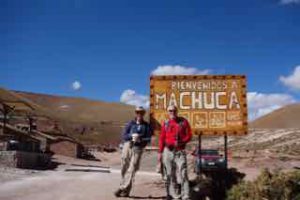
We cross an unusual landscape called a bofedal, a high altitude marsh, where two streams meet in a bottom, and high golden reeds grow rampant. The herders bring their animals here. A stone shelter sits on a low hill. An empty clothesline stirs in the wind. Billy points to a slab of mountainside rising beyond the moor. Over that is Machuca. He must think we think just another hour and a half of hiking straight up is encouragement.
At dinner a few days ago, we were talking about Toco, another volcano cone, our climb for the next day. It’s 5600 meters – 18,000 feet. Everything out here seems to be 18,000 feet. Mt Whitney in the California Sierras is the highest peak in the Lower 48 at 14,505. Toco is 3500 feet higher.
The typical hazards of elevation are headache, nausea. I know from personal experience. Also, he mentions, as an afterthought, the risk of stroke, what they call ischemia or blood clots in the brain. This is mind-focusing. Ken is a doc and describes the dangers of your heart pounding in an oxygen starved frenzy. Bad things can happen.
Instead, the last hiking day, we climb Copacoya, a 16,000 foot peak overlooking Tatio, a geyser field. According to Ken, our statistician and custodian of records, this would be a personal best, far higher than the 14,200, logged in the San Juans several years ago.
Copacoya is a beautiful hike but slow. Anything much beyond a trudge is impossible in the thin air. The views of the Atacama to the west and the Altiplano to the east are panoramic. There is an interesting plant, almost the only plant, the Jarreta, a bright green, moss-like blanket almost as hard as the rock it grows on. We climb past 14,500, and finally clear 15,000. We stop for lunch at the peak, at 15,750, a record I have no interest in surpassing.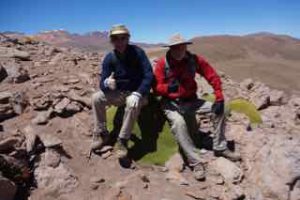
That night, our last, the elephant lurches down a miserable, stone-strewn track into a canyon. How the tires, loaded to the axles, survive seems like a gamble to me. Next to a cluster of steaming geothermal pools we stop.
We camp at 14,200. It is late afternoon but already cold at this altitude. It will become bitter cold with nightfall. I have been acclimatizing for a week but it’s for naught. The night is hard, the first in decades without the first wink of sleep. Each time my eyes close, my breath stops. In moments I am jolted awake, suffocating. I pull out a book and count the minutes till dawn.
At dinner, while I glumly consider the options of medical evacuation, Ken is full of cheer, smoking cigarettes and sloshing down wine. He is animated, explaining to our baffled companions his accountant daughter’s compliance challenges with American insider trading rules. They have no idea, of course, what he is talking about. I think it is contributing to my nausea. But he and they seem to be enjoying themselves.
After a sleepless night the chilly dawn feels surprisingly good. Why not, there’s no place to go but down. In the semi-dark I help Billy strike the kitchen tent. The water jug is frozen. The cold is biting but clean and astringent. As we descend into the desert my brain cells soak up the oxygen. I feel almost giddy. Billy takes one more detour, plunging off the Calama highway into the scrub. He drives and drives down a winding track, crashing through the desert shrubs.
Under a bright sun, in the middle of a sandy flat, he stops the truck and pulls a table from the equipment pile. He spreads a cloth, makes coffee, and puts out some breakfast. We enjoy one more moment surrounded by the Atacama. We sip coffee in the midst of this splendid piece of nowhere, a tabletop plunked in the middle of the desert. Ken lights a cigarette.
No Comments
No comments yet.
RSS feed for comments on this post.
Sorry, the comment form is closed at this time.
